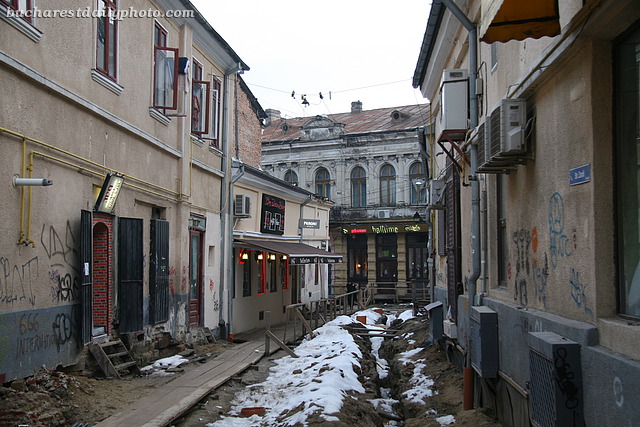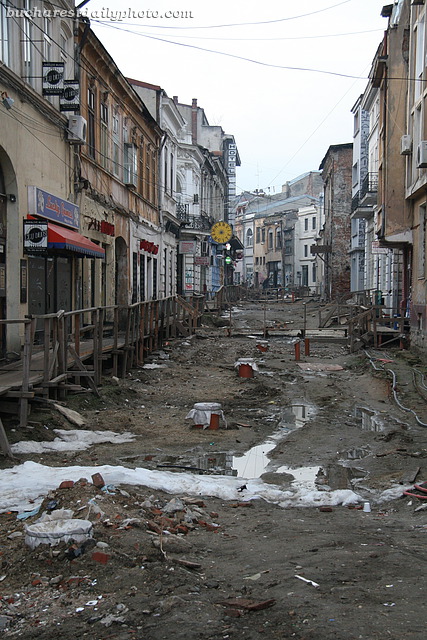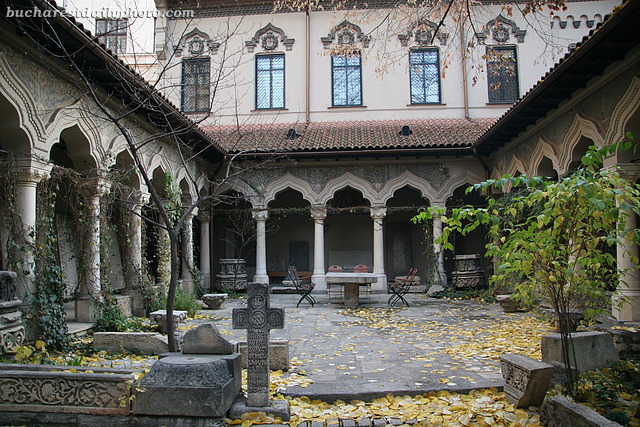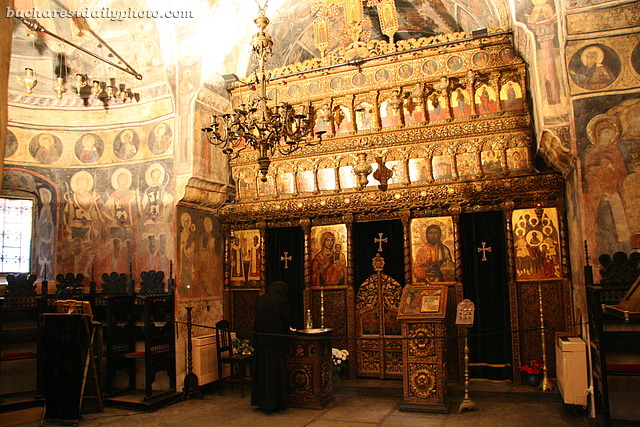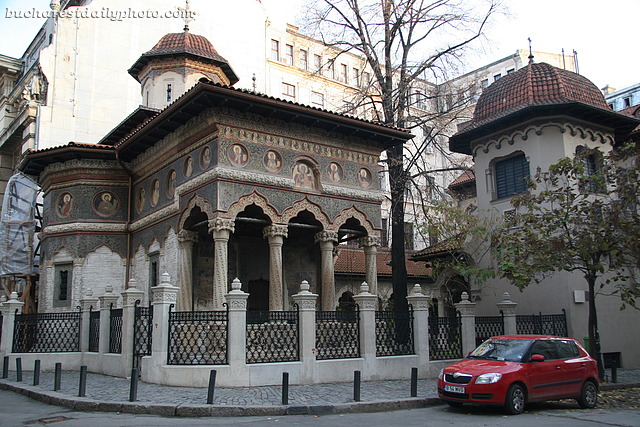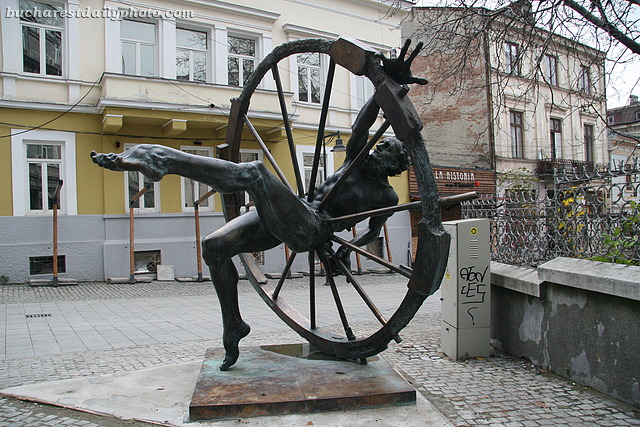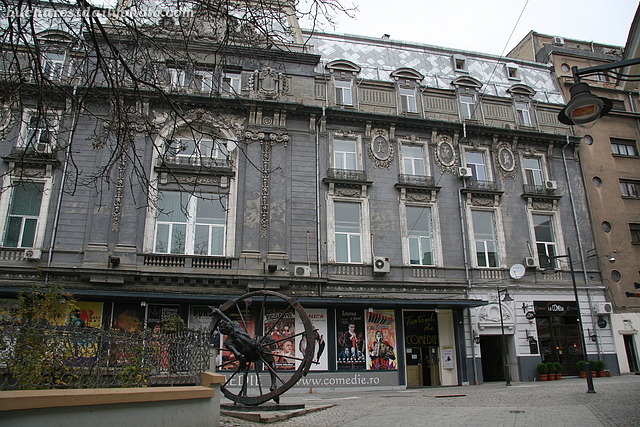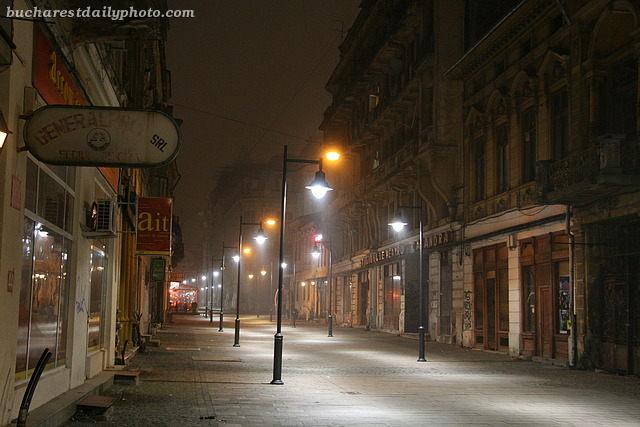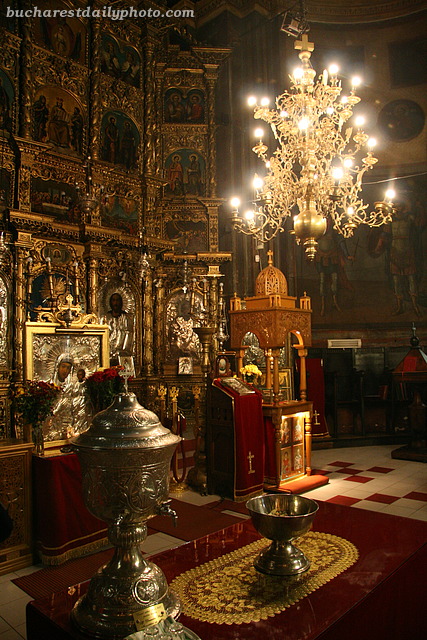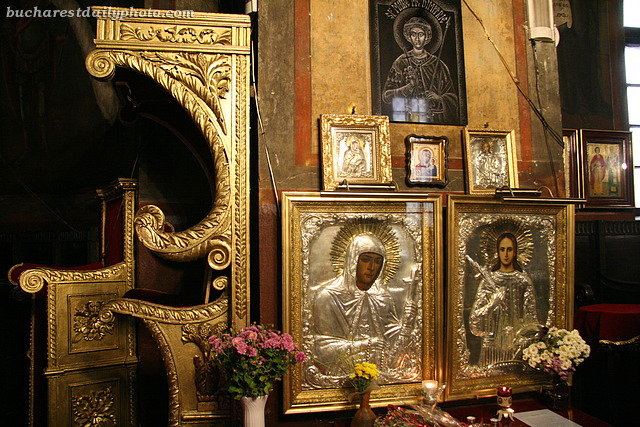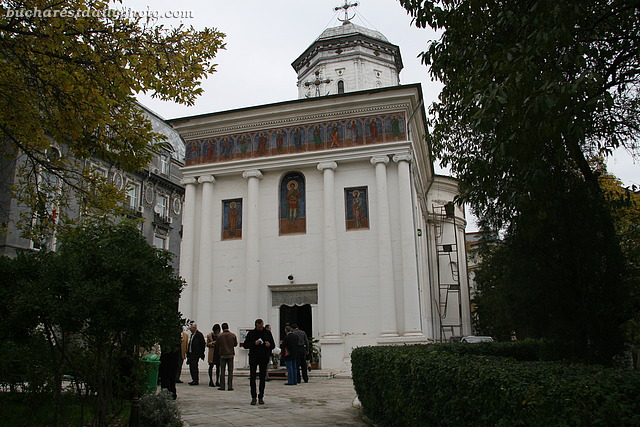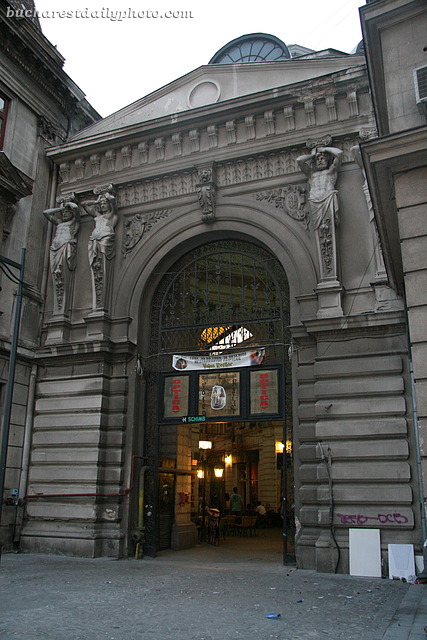Still in renovation, still in very bad shape 🙁
Alongside the church there is a small beautiful yard surrounded by a porticoes on three sides. This building has been added during the restoration done in 1899-1901 by architect Ion Mincu and if you look closely you’ll notice that the porticoes are inspired by the architecture of the church. This building shelters a library with a collection of old manuscripts, a refectory where conferences are held, and a collection of 18th century religious objects, some of them brought here from other churches and monasteries that were demolished in the communist years. The convent’s caretakers also work to restore old books, icons, other liturgical objects and clothes, to translate old books and to transcribe old musical scores digitally. The church is also famous for its choir which sings Byzantine music. I really like the courtyard with its old tombstones and fragments of old sculptures. I’ve seen it in many types of weather, on a sunny morning or under grey skies, when it was snowing or when it was raining and it always looks beautiful and has a peaceful and quiet feel.
In yesterday’s post I was saying that I believe it’s impossible to visit Stavropoleos and not be moved in some way. This feeling will be even stronger at the sight of the church interior. You’ll find the same fresco-covered walls and golden iconostasis found in most Eastern Orthodox churches but somehow they look more exceptional here. If you are Christian you’ll feel like the church interior encourages prayer and meditation. Even the tourists leave their cameras aside and sit quiet on the little benches. The black silhouette that you see in the photo is of one of the nun caretakers who was tending the candles.
This charming little church is one of the oldest in Bucharest. It was built between the years 1724 to 1730 during the ruling of Nicolae Mavrocordat (Prince of Wallachia 1719-1730) by the Greek monk Ioanichie Stratonikeas. Although tiny, every little detail is worth looking at: the richly adorned columns of the porch, the exterior paintings and carvings, the frescoes of the interior and the golden altar. I think it’s impossible to visit churches like Stavropoleos and not be moved in some way – I’m actually not sure that my photo does it justice, because it truly is one of a kind. In the past, the church was the centerpiece of a complex which included an inn and a monastery which was sustained from the incomes of the inn. They were demolished at the end of 19th century after being severely damaged during a fire, the church being the only part that remains from the original complex. Today the church is part of the Stavropoleos Monastery, an Eastern Orthodox convent. Stavropoleos is representative for the Brâncovenesc style which blends Ottoman and Western elements together with traditional Romanian architectural forms.
For today, a close up of the bronze statue that appeared in yesterday’s photo. Titled “Man, Time and Space”, the sculpture is the work of one of Romania’s contemporary artists, the sculptor Ion Mândrescu. Looking on the web for the sculptor’s other works I found out that a similar statue with the same name, was donated by Romania to the Council of Europe.
I’ve been told by one of my friends that I focus too much on the city center, especially the Old Town. I guess she’s right, I take many pictures in the Old Town because I think that it’s one of the most picturesque parts of Bucharest, and that it offers numerous opportunities for photography. Eventually I will move on to the neighbourhoods but at the time being I feel there’s still a lot to explore in this old part of the city. I pass through the Old Town often, and most of the time I just go on about my business, until one day something strikes me and I stop to take a picture. I sometimes wonder how others are seeing these pictures, if they are moved by the same details that made me decide to stop and take a closer look. Today’s photograph shows a corner of Old Town that caught my attention last week. I don’t know exactly what it was that suddenly moved me. Maybe it was the colored posters of the Comedy Theatre, a dash of color in a otherwise grey day. Maybe it was the ornate building, dating – if I’m not mistaken – from the beginning of the 19th century (if someone has a more definitive date please let me know as I wasn’t able to find one). Maybe it was the new art installation. In any case, here it is for you to enjoy.
The next two weeks I’ll be blogging from abroad. I do plan on having uninterrupted
service 🙂 so please continue to stop by.
I wrote this post in the wee hours of the morning so I hope it makes sense.
With the summer terraces gone, the streets in the Old Center look deserted, even though many of the cafes lining the streets are full until late at night. This is how Franceză Street looked last Thursday around midnight.
I don’t like to take pictures inside churches because there’s always someone praying and I feel like intruding. But being at the church with the occasion of a baptizing I waited until everyone left and snapped a few quick shots. I don’t know if you had the occasion of visiting a Eastern Orthodox Church before, but what you see in today’s photographs is a pretty typical interior. Icons are not considered to be idols or objects of worship by the Eastern Orthodox, the thinking being that an icon is like a window and that is not the physical object that is venerated but rather the individual shown. Therefore orthodox churches have many icons adorning the walls, in fact many of them are completely covered in icons or frescoes. Also, as you can see in the second photograph, icons are often illuminated by a candle or oil lamp.
Last Sunday I was invited to a baptizing at this charming church that goes by the name of Saint Dumitru Church, also called “of Oath Taking” because in the 17th century the parts involved in a trial would come here and take an oath to tell the truth while wearing the Holy Belt of the Virgin Mary. It is also called “Saint Dumitru at the Post Office”, because of its location, and in the past it used to be called “Saint Dumitru of Badea Bălăceanu”, after the name of one of the first patrons of the church. Although it is located in Bucharest’s Old Town, this church is far less popular than its close neighbour Stavropoleous Church.
This peaceful looking church has quite a stormy history. You can skip this part if you’re not interested. I won’t tell 🙂 There was a wooden church on these grounds as early as the 15th century but it was destroyed in 1595. Rebuilt in the beginning of the 17th century, it was left to ruin after its patron Bălăceanu fell from grace with the Prince of Wallachia Constantin Brăncoveanu. Rebuilt again between the years 1741-1746 and again left to ruin at the end of the 18th century. The church is then damaged in the earthquake of 1802 and what was left of it is burned in a fire in 1804. Then the cycle restarts. Rebuilt in 1843, the building burns down in Great Fire of 1847. The current building dates from 1852 but since then it was again damaged by earthquake and reinforced and renovated many times. After the First World War the church has been abandoned and proposed for demolition but thanks to a media campaign funds were obtained to renovated it. I think it looks pretty nice now.
I’ve already showed you photographs of the Macca-Vilacrosse Covered Passage but I can’t help showing it to you once more. Actually this time I’m posting a shot of the entrance to the passage from Eugen Carada Street, across from the National Bank in the historic Lipscani district.
